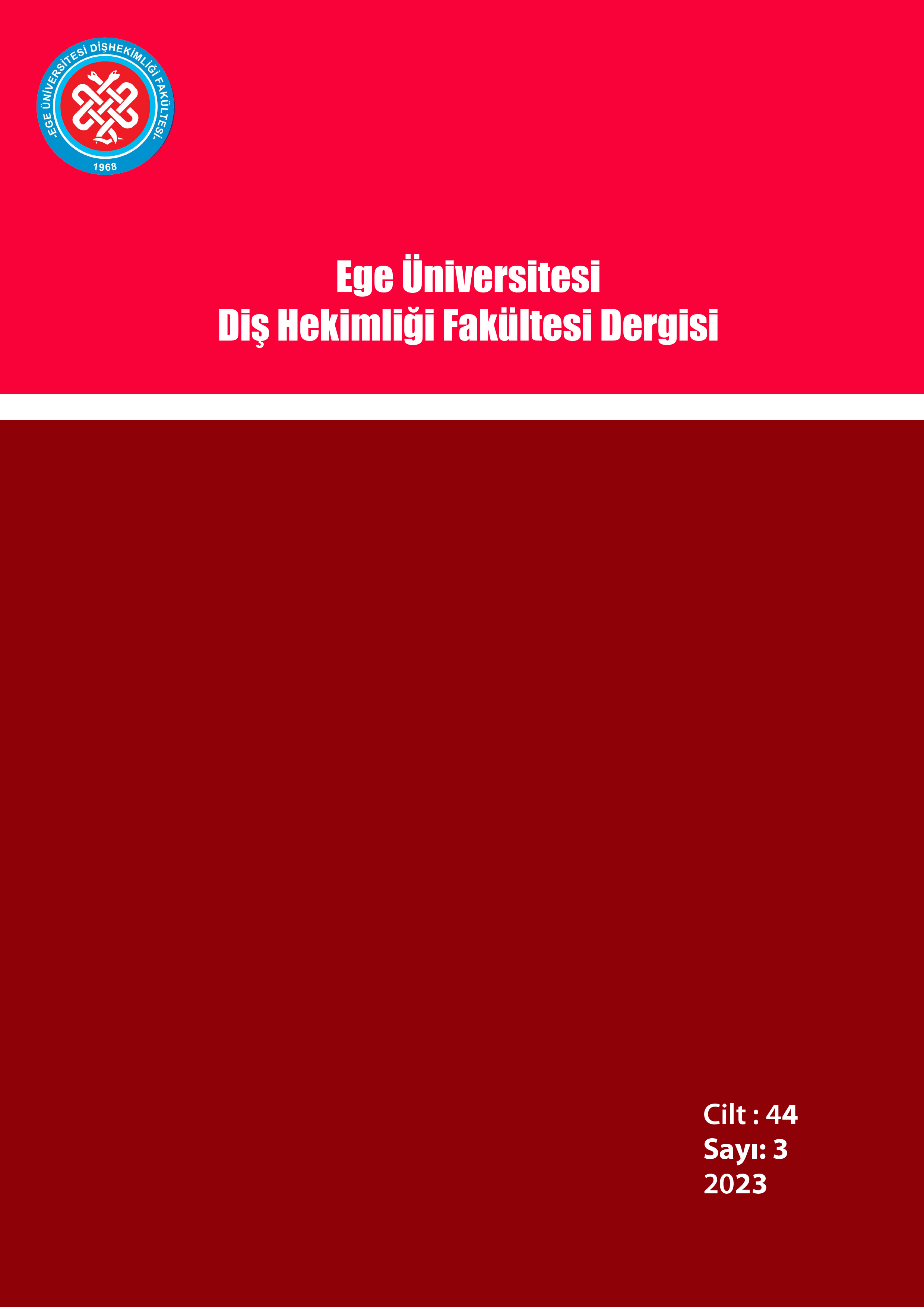
Bu eser Creative Commons Alıntı-GayriTicari-Türetilemez 4.0 Uluslararası Lisansı ile lisanslanmıştır.


Çift Taraflı Tam Dudak Damak Yarıklarında Kraniyofasiyal Morfolojinin Özellikleri
Enver Yetkiner, Servet Dogan, Ege DoganEge Üniversitesi Diş Hekimliği Fakültesi Ortodonti Anabilim DalıAMAÇ: Çalışmanın amacı çift taraflı tam dudak damak yarıklarında (ÇTDDY) kraniyofasiyal morfolojinin özelliklerini normal oklüzyonlu bireylerle karşılaştırarak incelemektir.
YÖNTEMLER: Ege Üniversitesi Ortodonti Anabilim Dalına tedavi amacıyla başvurmuş olan çift taraflı tam dudak damak yarığı olan ve tüm cerrahi tedavileri ortalama 2 yaşında farklı cerrahi teknik uygulamaları ile tamamlanmış toplam 15 bireyden (11-15 yaş) elde edilen uzak röntgen filmleri, aynı yaş aralığına ve etnik karakterlere sahip toplam 15 bireyden (11-15 yaş) oluşan kontrol grubuyla karşılaştırılmıştır. Premaksillası alınmış olan bireyler çalışma grubuna dahil edilmemiştir. Çalışmada Dolphin Imaging 11.5 software programı kullanılmış ve elde edilen veriler student t test ile istatistiksel olarak değerlendirilmiştir. Arnett Gunson- FAB analizi kullanılan çalışmada tüm ölçümler gerçek vertikal çizgiye göre yapılmış ve 45 farklı sefalometrik parametre ölçülmüştür.
BULGULAR: Operasyonları tamamlanmış olan ÇTDDY sahip hastalar, protrüzyonlu ve retroklinasyonlu premaksillanın, üst çenenin derinliğini ve yüksekliğini etkilemesi ile kontrol grubundan farklılık göstermiştir. Üst keser eğimi (Mx1-MxOP) ve maksiller okluzal düzlem açıları (MxOP-TVL) artmıştır (p<0.01).ÇTDDY sahip hastalarda daha konveks bir profil ve daha retrognatik bir mandibula saptanmış olup, yüz açısı (G-Sn-Pog ), yüzün alt 1/3 kısmı (Sn’-Me’), overjet (Mx1-Md1) azalırken, overbite (Mx1-Md1), alt keser tip projeksiyonu (Md1-Sn) ve çene ucu –burun tabanı mesafesi (Pog’-Sn’) artmıştır (p<0.05, p<0.01, p<0.001).Yumuşak doku kalınlığı (Pog-Pog’), özellikle üst dudak uzunluğu (Sn’-UL1) ve üst dudak kalınlığı (Mx1 labial-ULA),ayrıca nazofaringeal hava yolu boyutları ve uvulanın yumuşak damağa olan uzunluğu (PNS-uvula ucu) azalmıştır (p<0.01) (p<0.001).
SONUÇ: ÇTDDY sahip hastalarda kraniyofasiyal morfolojinin özellikleri aynı yaş, aynı cinsiyet, aynı etnik gruba ait normal kontrol grubuna kıyasla değişiklik göstermiştir. Premaksillanın ve maksiller kesicilerin retruzyonu; okluzal düzlem konumunun değisimine, overbite artışına ve mandibulanın aşağı ve geri rotasyonuna neden olmaktadır. Premaksillanın eksize edildiği hatalı cerrahi uygulama yapılan hastalar değerlendirme dısında bırakılmasına rağmen, erken dönemde uygulanan cerrahi başarısı, dudak damak yarıklı olgularda gelecek tedavi başarısını belirlemektedir.
The Evaluation of Craniofasial Morphology of The Patients With Bilateral Complete Cleft Lip and Palate
Enver Yetkiner, Servet Dogan, Ege DoganEge University, School of Dentistry, Orthodontics DepartmentOBJECTIVE: The purpose of the study was to investigate the features of the craniofacial morphology in complete bilateral cleft lip and palate patients (BCCLP) and to compare them with healthy children.
METHODS: Lateral cephalometric radiographs of 15 children (11-15 years old), who were referred to Ege University, Orthodontics Department with BCCLP and had been operated with different surgical techniques before the age of 2 years, were analysed and compared with those of a control group of 15 healthy children with the same age (11-15 years old), sex, and ethnic characteristics. Patients who had premaxillary excision were not included in the study group. Arnett Gunson-FAB analysis was performed to analyze the radiographs using Dolphin Imaging software programme Version 11.5. Forty-five cephalometric parameters were measured according to true vertical line. The resulting data were evaluated by student’s t- test.
RESULTS: The children with operated BCCLP differed significantly from the control group due toof the protrusion and retroclination of the premaxilla which affected the depth and the height of the upper jaw. Upper incisor inclination (Mx1-MxOP) and Mx occlusal plane (MxOP-TVL) were increased (p<0.01). These patients had more convex profile, and more retrognathic mandibula; Facial angle (G-Sn-Pog ), lower 1/3 of face (Sn’-Me’), overjet (Mx1-Md1) were decreased whereas overbite (Mx1-Md1), lower incisor tip projection (Md1-Sn) and chin to nasal base (Pog’-Sn’) were increased (p<0.05, p<0.01, p<0.001, respectively).Soft tissue thickness (Pog-Pog’), especially Upper lip length (Sn’-UL1) and Upper lip thickness (Mx1 labial-ULA) as well as nasopharnynx airway dimensions and soft palate length (PNS to uvula tip ) were reduced (p<0.01) (p<0.001).
CONCLUSION: The features of craniofacial morphology in BCCLP patients differed from controls of the same age, sex, and ethnic group. The retrusion of premaxilla and maxillary incisors, the change in occlusal plane, the increase in the overbite causes downwards and backwards rotation of the mandible. Even though incorrect surgical situations such as, exicision of premaxilla, was not evaluated in this study, primary surgical protocol affects the treatment success in future in the cleft patients.
Sorumlu Yazar: Enver Yetkiner, Türkiye
Makale Dili: Türkçe



